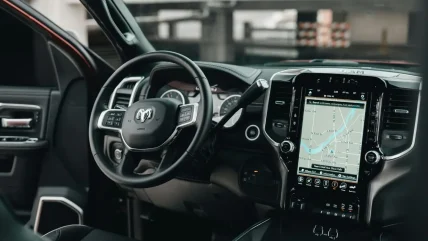
The business car fleet market in the UK has been experiencing significant growth, driven by advances in vehicle technology, evolving business needs, and the increasing preference for leasing over purchasing. However, as fleets become more connected and reliant on digital systems, they are also becoming more vulnerable to cyber-attacks. This article explores the profound impact of cyber insecurity on the business car fleet market in the UK, detailing the risks, challenges, and necessary measures for mitigation.
The Rise of Connected Fleets
Advancements in Fleet Technology
In recent years, the business car fleet market has seen a rapid increase in the adoption of connected vehicle technology. Features such as GPS tracking, telematics, and advanced driver-assistance systems (ADAS) are now commonplace, offering fleet managers improved efficiency, cost savings, and enhanced safety. The integration of Internet of Things (IoT) devices allows for real-time monitoring and data collection, which aids in predictive maintenance, route optimisation, and fuel management.
Benefits of Connectivity
The benefits of connected fleets are manifold:
- Operational Efficiency: Telematics systems enable better route planning and vehicle utilisation, reducing fuel consumption and operational costs.
- Safety Improvements: ADAS and real-time monitoring help in reducing accidents and ensuring driver compliance with safety regulations.
- Predictive Maintenance: IoT devices can predict maintenance needs before they become critical, reducing downtime and repair costs.
The Dark Side of Connectivity: Cyber Threats
Understanding Cyber Insecurity
Cyber insecurity refers to the vulnerabilities and threats posed to digital systems by malicious actors. For the business car fleet market, these threats can take various forms, including data breaches, ransomware attacks, and vehicle hijacking.
Types of Cyber Threats to Fleets
- Data Breaches: Fleet management systems store vast amounts of sensitive data, including personal information of drivers, GPS locations, and financial details. A data breach can lead to identity theft, financial loss, and reputational damage.
- Ransomware Attacks: Cybercriminals can deploy ransomware to lock fleet management systems, demanding payment to restore access. This can disrupt operations, lead to significant financial losses, and compromise data integrity.
- Vehicle Hijacking: Hackers can exploit vulnerabilities in connected vehicle systems to take control of a vehicle remotely. This poses serious safety risks and potential liability issues for businesses.
Case Studies: Real-World Incidents
High-Profile Cyber Attacks
Several high-profile cyber-attacks have highlighted the vulnerabilities within the automotive sector:
- Jeep Cherokee Incident (2015): Security researchers demonstrated the ability to remotely take control of a Jeep Cherokee, steering it, cutting the brakes, and shutting off the engine. This incident underscored the potential dangers of connected vehicle systems.
- FleetCor Breach (2019): FleetCor, a provider of fuel cards and workforce payment products, suffered a data breach exposing sensitive information of its customers. The breach highlighted the risks associated with centralised data storage in fleet management.
Impact on Businesses
The impact of these cyber-attacks on businesses can be severe:
- Financial Losses: Companies may face direct financial losses from ransom payments, legal fees, and compensations.
- Operational Disruptions: Attacks can disrupt fleet operations, leading to downtime and reduced productivity.
- Reputational Damage: Breaches can damage a company’s reputation, leading to loss of customer trust and potential business losses.
Regulatory Landscape and Compliance
UK Cybersecurity Regulations
The UK government has been proactive in addressing cybersecurity threats, introducing regulations to protect businesses and consumers:
- General Data Protection Regulation (GDPR): Although primarily focused on data protection, GDPR mandates stringent cybersecurity measures to protect personal data.
- Network and Information Systems (NIS) Regulations: These regulations aim to enhance the security of critical infrastructure, including transport sectors, by requiring businesses to implement robust cybersecurity measures.
Industry Standards and Best Practices
In addition to government regulations, several industry standards guide businesses in securing their fleets:
- ISO/SAE 21434: This standard focuses on cybersecurity engineering for road vehicles, providing guidelines for identifying and managing risks.
- National Institute of Standards and Technology (NIST) Framework: While primarily a US-based standard, the NIST framework is widely recognised and provides a comprehensive approach to managing and reducing cybersecurity risks.
Mitigating Cybersecurity Risks
Adopting a Proactive Approach
To mitigate cybersecurity risks, businesses must adopt a proactive approach:
- Risk Assessment: Conduct regular risk assessments to identify vulnerabilities within the fleet management systems.
- Employee Training: Ensure that employees are aware of cybersecurity threats and best practices. Regular training can help prevent phishing attacks and other social engineering tactics.
- Incident Response Plan: Develop and maintain an incident response plan to address potential cyber-attacks swiftly and effectively.
Investing in Technology
Investing in advanced cybersecurity technology is crucial:
- Encryption: Implement robust encryption protocols to protect data in transit and at rest.
- Multi-Factor Authentication (MFA): Use MFA to add an extra layer of security for accessing fleet management systems.
- Intrusion Detection Systems (IDS): Deploy IDS to monitor network traffic for suspicious activity and potential breaches.
Collaborating with Cybersecurity Experts
Engaging with cybersecurity experts can provide valuable insights and expertise:
- Third-Party Audits: Regular third-party audits can help identify vulnerabilities and ensure compliance with industry standards.
- Managed Security Services: Consider outsourcing cybersecurity management to specialist firms that can provide round-the-clock monitoring and protection.
The Role of Manufacturers and Technology Providers
Responsibility of OEMs
Original Equipment Manufacturers (OEMs) play a crucial role in securing connected vehicles:
- Secure Design: Incorporate security measures during the design and development of vehicles. This includes secure coding practices, vulnerability testing, and regular software updates.
- Collaboration with Security Researchers: OEMs should work closely with security researchers to identify and patch vulnerabilities.
Fleet Management Software Providers
Providers of fleet management software must prioritise cybersecurity:
- Regular Updates and Patches: Ensure that software is regularly updated to address known vulnerabilities.
- Secure APIs: Use secure Application Programming Interfaces (APIs) to prevent unauthorised access to fleet data.
Future Outlook: Cybersecurity in an Evolving Market
Increasing Complexity
As the business car fleet market continues to evolve, the complexity of cybersecurity challenges will increase. The adoption of autonomous vehicles and the integration of artificial intelligence (AI) will introduce new vulnerabilities that must be addressed.
Emerging Technologies
Emerging technologies such as blockchain and quantum computing hold potential for enhancing cybersecurity:
- Blockchain: Blockchain technology can provide a tamper-proof ledger for tracking vehicle data, enhancing security and transparency.
- Quantum Computing: Quantum computing promises to revolutionise encryption methods, making it significantly harder for cybercriminals to crack encrypted data.
Conclusion: Navigating the Cybersecurity Landscape
The impact of cyber insecurity on the business car fleet market in the UK is profound and multifaceted. As fleets become increasingly connected, the potential risks and vulnerabilities grow, posing significant challenges for businesses. By adopting a proactive approach, investing in advanced technologies, and collaborating with experts, businesses can mitigate these risks and ensure the security and efficiency of their fleets. The role of manufacturers and technology providers is also critical in developing secure systems and fostering a culture of cybersecurity. As the market continues to evolve, staying ahead of emerging threats and adopting innovative solutions will be key to navigating the complex cybersecurity landscape.





